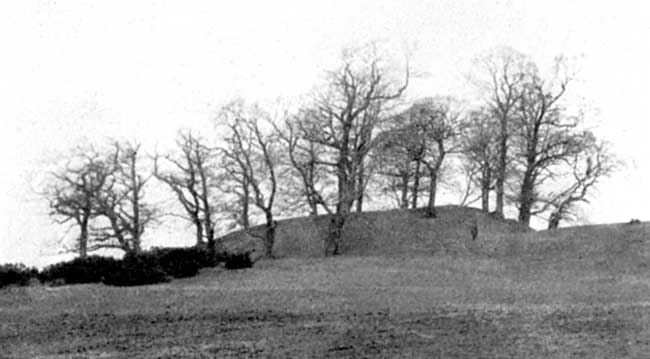Bothamsall Mound
By THOS. M. BLAGG, F.S.A

Bothamsall mound.
THIS mound is locally known as “Bothamsall Castle.”
In 1893, which I am appalled to realise is thirty-seven years ago and several years before the Thoroton Society was born, I wrote a letter to the "Local Notes and Queries" column of the Nottinghamshire Guardian, suggesting that this artificial hill might be the Moot Hill or meeting place for the Wapentake of Bassetlaw. We know where the Wapentakes of Newark, Bingham, Rushcliffe and Broxtowe had their Moots, but we don’t know where Bassetlaw met, and this hill, with an amphitheatre at the top and situate in the middle of the Wapentake seemed a likely place, in the absence of any marked out-works proving it to be a Norman Castle of the motte and bailey type instead.
The closest parallel to it that I know, is the mound at Burgh near Wainfleet, in Lincolnshire, which also has a cup-shaped top, overhangs a road, and was the site until recent years of the Shrove Tuesday games of the village, as were mounds at East Bridgford, Car Colston and elsewhere. I have to admit, however, that I have not seen the Burgh mound for twenty years, that I have no remembrance as to whether it shews out-works or not and that I do not know whether anything definite is known about it as to its being the site of the "caput" or chief manor of a Norman baron, and until I know more about the Burgh mound, would not like to theorise too much about this one.
However, the weight of modern evidence is in favour of considering these mounds as Norman castles of the motte and bailey type, erected immediately after the Conquest for the purpose of garrisoning the country and holding the Baronies to which the forfeited lands had been assigned.
This mound is the loftiest of its type in Nottinghamshire, although perhaps it must yield place to Laxton in the total achievement of its works, when one takes into account the out-works. It is about 150yds. in circumference, with a parapet on the top 70yds. in circumference and 20yds. in diameter on its inner face. There is a glacis to the marshes of the Meden below and some trace of works which might have constituted an outer bailey. If this theory is correct, it is a Norman castle mound, and the present high road intersects the bailey, the slight traces remaining on the east side being explained by the rampart having been levelled to allow of agricultural operations.
Bothamsall before the Conquest was the property of Earl Tostig, brother to the usurping King Harold, and at Domesday was retained in the King’s hands and not granted to the neighbouring Norman barons, Roger de Boulli or Roger Pictavensis. It became, as so much of Nottinghamshire, parcel of the Duchy of Lancaster; but as a King’s Manor it can never have been the “caput” of a feudal lord, and I can only assume that this mound was a castle motte of the 11th century, abandoned after the occupation of the country became more assured.
It would be interesting to excavate the parapet. If it is a Norman motte one would expect to find that it was caused by the ruined walling of a shell keep, fallen down, and the debris overgrown with turf. If neither walling nor traces of stockade were found within the banks, then the theory of an earthen amphitheatre, and the possibility of a Moot hill of the Wapentake might be reconsidered.
.